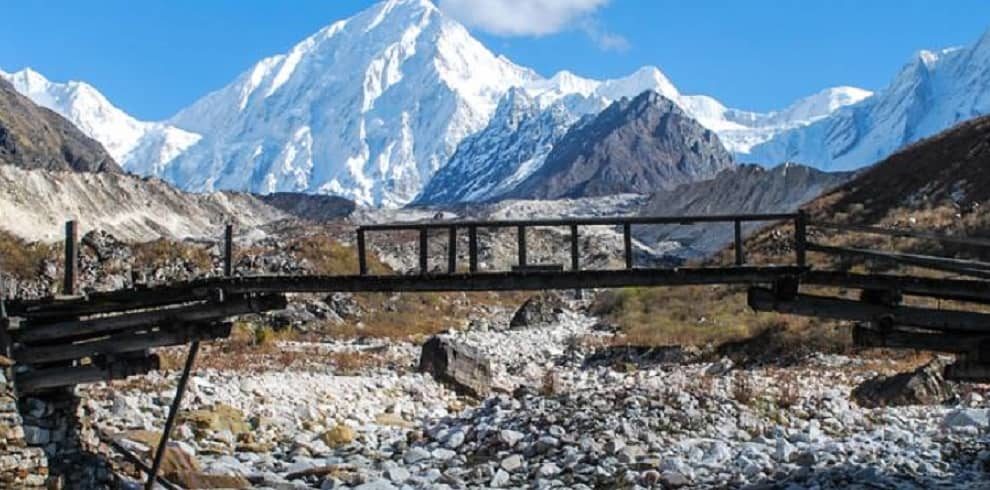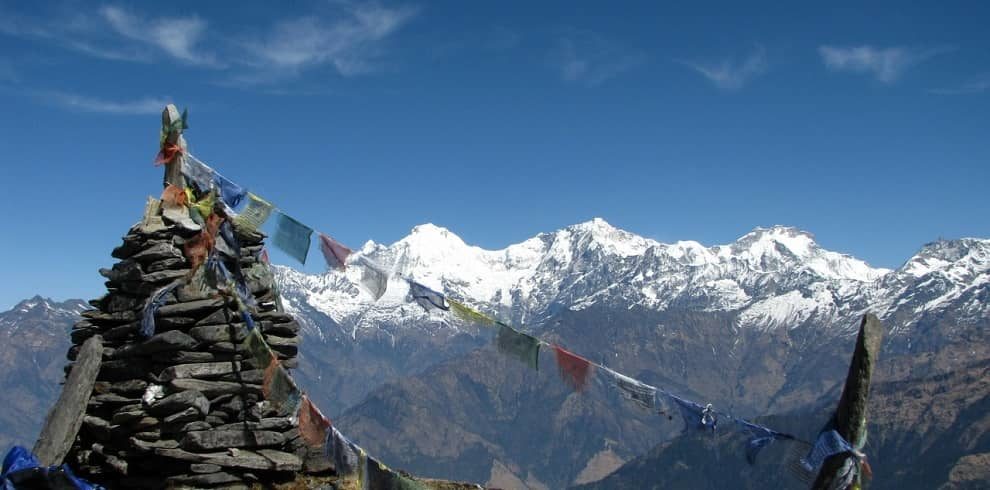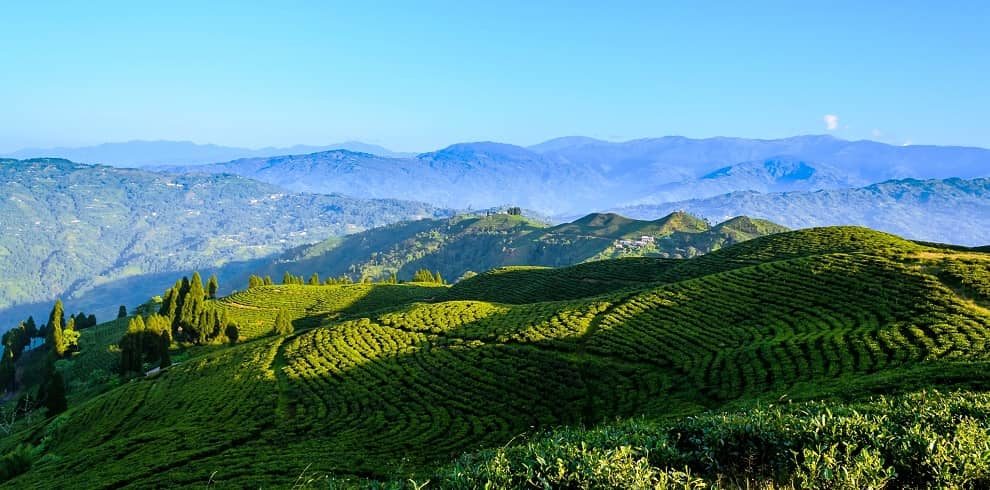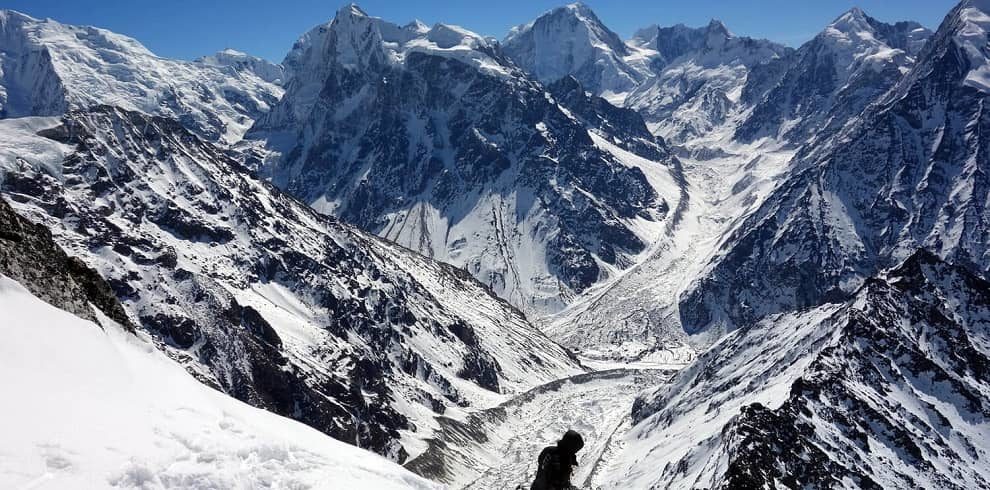Introduction To Manaslu Circuit Trek In Nepal
The Manaslu Trek first began in 1992, and it quickly gained popularity due to its enthralling natural essence, exclusivity, and unspoiled beauty.
The Manaslu trek takes us along the Nepal-Tibet border, allowing us to learn about both Hindu and Buddhist cultures and lifestyles.
The off-the-beaten-path pathways lead us through lush forests with rhododendron, pine, cedar, birch, and juniper trees, as well as lovely meadows.
The Manaslu Journey is a 16-day tea-house trek that circumnavigates Manaslu (8,156m/26,758ft), the world’s eighth highest peak.
The walk includes Hindu and Buddhist culture, wonderful fauna, rhododendron, and other blossoms, furious rivers, hazardous bridges, massive mountains, and breathtaking scenery.
Manaslu is one of the most graceful 8,000-meter mountains in Nepal, surrounded to the west by the Annapurnas and to the east by the Ganesh Himal.
However, only about 2% of trekkers reach Manaslu. Perhaps because Manaslu is distant and physically difficult, despite the culturally enlightening and scenically uplifting nature of the excursion.
The circuit leads you from the sweltering lowlands to the huge Budhi Gandaki gorge, which has turquoise streams and beautiful waterfalls.
Several suspension bridges, some of which are very high and often very lengthy, will be crossed along the walk.
The Manaslu Journey is a long trek in the isolated Nepali Himalayas, so you’ll have plenty of opportunities to customize your schedule based on your preferences.
This vacation is quite adaptable, and we can customize side trips to meet your specific needs.
The Manaslu Trek starts with a beautiful journey from Kathmandu to Arughat and then to Soti Khola. The journey to the trekking area takes an entire day.
The adventure truly begins on the second day, when we leave Soti Khola and go to Machha Khola (890m / 2,965ft). As you pass through gorgeous forests, steep peaks, terraced fields, and suspension bridges, the ride will be enjoyable.
We head to Doban (1,070 m/3510 ft) after a pleasant trek to Macha Khola, passing via the Tharo Khola, which runs through a rocky cavetto to Khorla Besi, a traditional Gurung village.
We continue climbing from Khrola Besi to Tatopani, then cross the Budhi Gandaki on a suspension bridge to reach Doban. The Nepali word for the confluence of two rivers in Doban.
We leave Doban the next day for Philim. The trail is rocky and climbs and descends. The routes provide spectacular views of Sringri Himal.
When you get to Philim, you’ll see that it’s a sizable Gurung community. In their village fields, the Gurungs raise corn and millet.
We leave Philim for Deng on our fifth day. The walk to Euwa and subsequently Deng village is quite rewarding, with spectacular waterfalls and a few suspension bridges.
This Buddhist settlement has sacred monasteries and rivers, and you can see the magnificent snow tops from Deng.
Our Manaslu trip continues the next day, with Ghap as our target. We begin by descending from Deng before ascending to Rana Bridge.
From here on out, you’ll be entering Buddhist communities, as evidenced by Mani walls and stone statues visible from the path. You will pass a suspension bridge just before arriving at Ghap.
Our journey continues as we go from Ghap to Namrung on our walk. The path passes via Prok, a well-known viewpoint for viewing Siringi Himal.
We begin our walk to Lho the next morning after spending the night in Namrung. The trip from Namrung is around 11 kilometers long and includes crossing the Budhi Gandaki River and walking through the forest.
The stunning Ganesh Himal (7,422m) and Mt. Himalchuli (7,893m) vistas from Namrung hamlet are well-known.
This is a lengthy journey, and we must push ourselves harder every day. The next day’s destination after Lho is Samagaun. To go to Shyala Village, we first descend from Lho and cross the Thusang Khola.
Views of Himal Chuli, Peak 29, Manaslu, and Ganesh Himal can be found all around Shyala Village. We hike to Samagun after taking in the views from Shyala Village.
Samagun is a small community with a monastery and stone-built dwellings. We’ll be staying at Samagun for rest and acclimatization because you’ll have covered a lot of ground by this point.
Birendra Lake, Pungyen Monastery, and Manaslu Base Camp are among the places of interest in the Samagun settlement and surrounding environs.
We resume our hike with determination to reach Samdo, a Tibetan refugee town, after resting for a day at Samagaun.
As we pass through pasture lands and ascend to the valley through birch and juniper forest, the journey should be pleasant. Beautiful views of various mountains, including the huge Manaslu, can be seen from Samdo.
You will have covered a lot of ground by this stage in the walk. You should be grateful that crossing Larkya La Pass (5,160m / 16,929ft) is only a day away. As we leave Samdo for Dharamsala, the anticipation will grow.
Mani walls and prayer flags can be seen on the side of the pathways. The Larkya glacier is another fascinating sight. To get to Dharamsala, also known as Larkya La Phedi, we travel through the Salkha Khola valley and ascend.
Finally, on the thirteenth day of our trek, we will pass Larkya La Pass, which is also the highest point on our journey. Early in the morning, we set out on the Larkya Glacier moraine trail, passing past a few frozen lakes. Larkya La Pass is one of the Himalayas’ longest passes.
Views of Himlung Himal, Annapurna II, Cheo Himal, and Kanguru can be had from the pass. To get to Bhimtang, we cross the Larkya La Travel and pass through various yak pastures.
We’ve completed a full loop of Manaslu by reaching Bhimtang. The return journey has begun. We leave Bhimtang behind and travel south to Gho. In comparison to the previous day’s trek, today’s walk is a little easier.
You may encounter sheep, horses, and jackanapes as we go through dense pine forests (a type of monkey).
The trek’s final day takes you from Gho to Dharapani. The trip to Telje village, which is located along the Marsyangdi River, is primarily downhill. Then we make our way up to Dharapani, an alpine town.
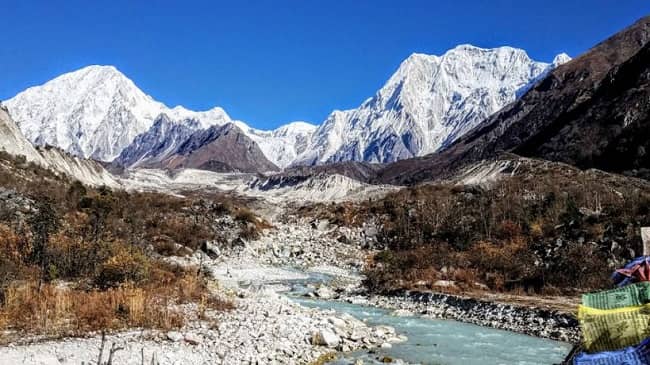
The Manaslu and Annapurna Circuit trails intersect in this town.
We take a local bus from Dharapani to Besisahar on the last day. We will drive through various beautiful villages, as well as the towns of Bhulbhule and Khudi, on our way to Besisahar.
After catching a bus to Kathmandu from Besisahar, the Manaslu trek comes to an end.
Please keep in mind that the Manaslu Circuit requires a special permit from Nepal’s immigration office. Because we need your original passport with a Nepal visa to apply for permission, you must arrive in Kathmandu at least two office days (weekdays) prior to the trip departure date. Additionally, you will have more time to attend the trip briefing. During the trip briefing, we will double-check that you have all of the necessary gear, equipment, and clothes, as well as tell you about the trip’s specifics. The journey package also includes public bus tickets, but if you want a more comfortable ride, we can charter a Jeep for you at an extra fee.
Highlights Of Manaslu Circuit Trek In Nepal
- From Kathmandu to Soti Khola, take a scenic journey.
- Views of some of the world’s highest peaks, such as Manaslu (8,156m), LamjungHimal, Mt.Annapurna II, and others.
- Trek through the gorge of the Budhi Gandaki River.
- Larkya La Pass (5,106m/16,751ft) is the highest point on the route.
- Biodiversity abounds, and the view is breathtaking.
- Awe-inspiring nature and wildlife
- An understanding of Hindu and Buddhist culture
- Possibility of seeing endangered species such as the snow leopard in the wild
Benefits Of Manaslu Circuit Trek In Nepal
- On arrival, there is a complimentary transfer from Tribhuvan International Airport to the hotel, and on departure, there is a complimentary transfer from the hotel to the airport.
- At our store, you can store extra luggage for free during your stay.
- Pulse oximeters are used to measure blood oxygen saturation levels at high altitudes in order to detect early indicators of altitude sickness and other health hazards.
- Medical supplies
- Arrangements for sleeping bags and down jackets if you do not have your own
Equipment list for Expedition
We recommend that you bring only the essential clothing and equipment for the walk. Your primary luggage will be carried by porters, but your luggage weight limit is 9kg. A porter will be shared by two hikers, and they will not carry more than 18kg of luggage. We do, however, expect you to bring a backpack with all of your important documents and valuables. You may buy or rent clothing and equipment in Kathmandu, but make sure you get the proper size.
Although we recognize that you have your own tastes, we have compiled a list to assist you in packing.
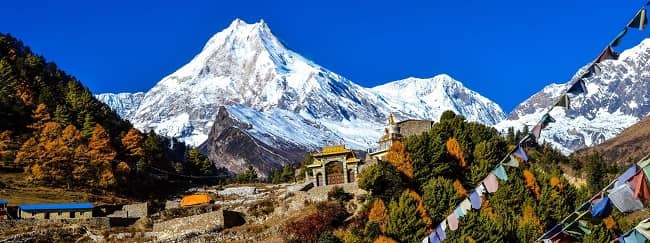
Head
- Scarf or hat for the sun
- Winter hat, insulating hat, or a hat with a wide brim
- Extra batteries for the headlight
Face
- Sunscreen
- Sunglasses that block UV rays
- Wipes for the face and body
Hands
Lightweight gloves
Heavyweight winter gloves
Body
- Shirts for hiking
- Shirt with a long sleeve made of synthetic fiber.
- Rain jacket with hood
- Jacket made of fleece
- Cotton pants that are light and airy.
- T-shirt (bring lightweight wool)
- Underwear made of polypropylene
- Jacket with down feathers (available for rent in Kathmandu)
- Sweater
- Jacket and pants that are waterproof
Footwear
- Boots for Hiking
- Socks made of thick wool (Take an extra pair of thick light socks)
Essential gear
- A daypack or a backpack (Size depends on whether you take a porter or not)
- Bottle with a heating element
- Purification of water
- Pole for hiking
- Bag for sleeping (-15 degree bag is best for high altitude trekking)
Toiletries
- a drying towel of medium size
- Toothbrush
- Toothpaste
- Deodorant/floss/toilet paper
- Biodegradable soap in a bar
- a pair of nail clippers
- Mirror, little
Personal accessories
Money
Watch
Cell phone
Camera
Extra items
- Kit for first aid
- Extra passport pictures and passport photocopies
- Pencil and notebook
- Binoculars
Cost, Accommodation, Best Time & Info of the trek
Why should I consider going on this Trek?
The Manaslu trek takes you through a rural Nepal region that is relatively new and undeveloped. Because settlements are few and far between, you’ll spend much of your time in nature, away from the everyday grind.
The Manaslu Circuit Journey Start
You’ll arrive in Kathmandu at least two weekdays (office days) before the trek’s start date. This is necessary since obtaining restricted area permission to Manaslu will take one day, and we will require your passport and visa to apply for this permit. This day will also be used for trek briefing. We’ll double-check your bags at the trek briefing to make sure you have everything you need. We’ll also use this time to deliver important trek information. We drive from Kathmandu to Sotikhola through Arughat on the trip’s departure day, which is where the trek route begins.
The package includes local transportation (KTM to Arughat to Soti Khola, then Dharapani to Besisahar, and back to Kathmandu). For an additional fee, we can arrange a private jeep.
Free airport pick-up/drop service
For valued clients who have booked a package with us, we provide complimentary airport arrival and departure transfers. At the airport, our agent will be holding a leaflet with your name on it. They will greet you and give you a marigold garland or khada as a welcome gesture before driving you to your accommodation in a private vehicle.
We ask that all of our valued clients arrive in Kathmandu by 3 p.m. at least one day prior to the trip departure date. We need time to conduct a trip briefing, during which we offer you with information on your journey and inspect your equipment (luggage) to ensure that you are well prepared for the walk.
Accommodation Details During The Trek
The Manaslu Circuit tour includes a fifteen-night stay at the best lodges in the hiking districts. At Sotikhola, Namrung, Lho, Samagaun(2N), Bhimtang, and Gho, we give seven nights’ accommodation in rooms with a private connected bathroom. At Machha Khola, Doban, Philim, Deng, Ghap, Samdo, Dharamsala, and Dharapani, you will stay eight nights in a standard room.
Hotel accommodations in Kathmandu for three nights before and after the trek may be required, but they are not included in the package. There are hotels in Kathmandu to suit all budgets and inclinations.
In trekking locations, hot showers and Wi-Fi will be offered at an additional cost.
The Meals During The Manaslu Trek
This enthralling trip in Nepal takes you to high altitudes near the world’s eighth highest peak, implying that your body will require adequate nutrients. You’ll have enough of excellent, hygienic, and nutritious meals, but you won’t have as many options as you would in a big city.
In the trek regions, there will be 16 breakfasts, 16 lunches, and 15 dinners.
The following are some of the most popular menu items:
Oatmeal, Corn Flakes, French toast with jam, butter, and cheese, Honey Tibetan bread or Chapati, and local Tsampa porridge are among the sixteen breakfast options. Eggs, pancakes, muesli slices of bread, fruits and vegetables, and hot beverages (varieties of teas and coffees, hot chocolates, etc.)
Dhal, Bhat, Tarkari, Tibetan Bread, Soups, Momo (dumplings), Macaroni meals, Tenduk Spaghetti Noodles, Thukpa, Pasta, Vegetable curry, Potatoes, Vegetables, Salad Pizza (Tomato, Mushroom, Mixed), Snacks (Papad, Prawn), Desserts (Rice Pudding, Apple Pie), etc.
Fifteen meals – Dhal, Bhat, Tarkari, Tibetan Bread, Various Soups, Sherpa Stew, Steaks, Sandwiches, Momo (dumplings), Macaroni, Tenduk Spaghetti, Noodles Thukpa, Pasta, Vegetable Curry, Potato items, Vegetable and Salad Pizza (Tomato, Mushroom, Mixed), Snacks (Papad, Prawn), Korean Raman,
Menus in trekking regions include native, Asian, and western cuisine, however, the menus get shorter as we ascend higher.
Fresh veggies and ample liquids (green tea, lemon tea, hot lemon, garlic soup (obligatory), and ginger tea) are highly recommended for health advantages.
Though there will be lots of non-vegetarian options available in hike locations, we do not advocate them because the meat may not be hygienic. Similarly, we recommend avoiding alcohol, hot chocolates, caffeinated beverages, and dairy products, especially cheese.
All personal bills (alcohol drinks, hot (tea/coffee), and cold drinks) in tea houses, lodges, or cafés are excluded from the package, save for standard meals (breakfast, lunch, and dinner with seasonal fruits).
Best time for the Trek
At some times of the year, this is a simple hike. Manasu Circuit Trek is only available from February to June and August to December.
The optimum months to climb Manaslu are March to May and September to November. During the winter months of December to February, heavy snowfall closes the lodges in Dharamsala, making it difficult to cross the Larkya La Pass.
The rainy season, which lasts from June through August, is prone to landslides and slips. As a result, we do not advise anyone to go trekking during the cold or rainy seasons.
Manaslu Trek – March to May (Spring)
The greatest time to walk the Manaslu Circuit is now. The weather is ideal, and you’ll have spectacular views of Mt. Manaslu and the surrounding glaciers.
Temperatures begin to rise in mid-March, and with bright skies, the snow mountains are at their most beautiful. Lowlands begin to heat up in April and May. In the high mountains, the temperature is neither chilly nor hot. The temperature drops significantly at night. This is a popular trekking season for many people. The rhododendron flowers in various colors may be seen from the path. Temperatures in the highest mountains (Lho, Samagaun, Samdo, Dharmasala, and Bhimtang) can reach 18°C during the day and -4°C at night.
Manaslu Trek- September to November (Autumn)
This is also one of the best times to go on the Manaslu trek in Nepal, which attracts a large number of trekkers. As the monsoon begins to fade, a great trekking climate emerges. The temperature reaches 20°C during the day and drops to -6°C at night.
As the season progresses, the skies clear up, revealing breathtaking views of the mountains. Many hikers go during this time to enjoy the festive atmosphere. Dashain and Tihar, two of Nepal’s most important festivals, fall at this time.
Because of the sunny sky and bright days, November is the busiest month. The daytime temperatures are fairly consistent and stable, allowing you to enjoy the scenery, which includes towering snowcaps. The temperature begins to drop in December, and snow begins to fall, making the walk nearly impossible.
The weather in the mountains is fickle and changes frequently.
Acclimatization
Altitude sickness is prevalent among trekkers in high mountains and can be avoided, but if it is severe, it requires rapid treatment. Symptoms of altitude sickness are most common at levels above 3500 meters. We spend four to five nights in trek zones with altitudes over 3500m after leaving Samagaun (3530m / 11581ft). The highest point of our journey is Dharamsala, at 4480m (14698ft).
To avoid mountain sickness, we created the 16-day Manalsu Circuit Trek. Starting from Sotikhola (730m), we hike for seven days to reach Samagaun, giving our bodies enough of time to acclimate to the high altitude.
We’ll also be ascending gently and stopping at Samagaun for a day. In addition, we will drink enough of water every day of our walk to ensure a smooth crossing of the Larkya La Pass.
We value your health and safety above all else, and we pledge that we will not jeopardize it at any cost. We will descend promptly if you are gravely affected. The trip leader has the authority to decide whether the team should descend or continue on the routes, taking into account everyone’s best interests.
Manaslu Trek Trip Grade: Fitness level | Medical Advice & Health Requirements
The Manaslu Trek Trip grade is a difficult yet rewarding trek. Because trekking at high elevation is challenging, you will be trekking for 5 to 7 hours in the highlands. To cross the 5,160m Larkya La Pass, you must be physically healthy and able to hike 4 to 6 hours per day.
It would be advantageous if you have prior trekking expertise. This trek is suitable for fit novice trekkers. However, the more fit you are, the more enjoyable this walk will be. At least one month prior to the walk, we recommend that you engage in stamina-building activities such as cycling, swimming, or going to the gym on a regular basis.
We take many rests to admire the mountain views, so trekking at the locations is fairly comfortable.
Long climbs, sharp descents, and forward trails in rocky slopes and woodlands are all part of the journey routes. This walk is not recommended for people with delicate medical problems such as heart or lung disease.
Manaslu Trek in Group | Private Tours in Manaslu Region
A minimum of two trekkers is required for the Manaslu Circuit Trek. The group will be led by our qualified trek leader. We assign an assistant guide to groups of 12 or more. The larger your group, the greater the discount you will receive. You will not receive discounts if we form a group.
The Manaslu Climb takes place in a restricted area, and special permits are only provided to groups of at least two trekkers due to the nature of the trek. We welcome lone trekkers to our group, but we are unable to organize Manaslu Circuit treks for them.
A typical day on the Manaslu trek
Every day takes you to new destinations as you travel through beautiful landscapes and lush vegetation. You’ll be snapping pictures, touring local communities, trying new foods, and seeing high-altitude species and lifestyles while taking in the breathtaking Himalayan backdrop.
Our guide/Sherpa will accompany you on the journey, showing you around and providing you with information about the areas you will be seeing. Porters will be assigned to carry your bags.
The day begins with a nice cup of tea or coffee in the morning, followed by a hearty breakfast, before setting out on the trails between 7 and 8 a.m., depending on the length and nature of the journey. You will have lunch after three to four hours of trekking, followed by an hour of recuperation. Then we’ll continue on our way; the afternoon walk will be shorter in general. We nibble on extra dietary food after we arrive at our location. You’ll have time to explore the area before it gets dark. Dinner will be served at approximately 7 p.m.
We engage in cordial chats and review the events of the day after dinner and before going to bed. The excursion leader/guide will give you an overview of the next day’s activities. You can read books, learn Nepali phrases from the crew, watch mountaineering movies, or play games like monopoly or cards after the briefing.
How to Communicate During the Trek?
For a nominal fee, you can use the internet at the lodges, but after you reach high elevations, you’ll have to communicate via phone.
Our office will connect with all of our valued clients by Signal, WhatsApp, phone, Messenger, and other means at least once a day to ensure that they are fine, safe, and comfortable.
You might get some signals along the route, depending on the network you’re using, but they’re not particularly strong at high altitudes. In Kathmandu, though, you may easily obtain a local sim card.
In most cases, you will be able to connect to the internet at all of the lodges/hotels where you will be staying.
Wi-Fi is usually available during the walk-in lodges/lodges for an additional fee.
Extra personal expenses on trekking
In Kathmandu, the clients are responsible for their own meals and lodging. You may book them conveniently online, or we can do it for you if you want.
Similarly, you must pay for visa processing, travel insurance, beverages, trip snacks, hot and cold drinks, souvenirs, and tips to trekking crew members, among other things. Bringing cash (Dollars) and changing it to Rupees is recommended. In the Nepali market, only Rupees are accepted.
Electricity, battery recharge, water on trekking
In all lodges, electricity for camera and phone recharge is available at an additional expense. During the trip, you can either buy pre-packaged mineral water or bring boiled water with you. You will also receive a water-purifying pill.
We advise against drinking water from rivers or taps because the water may be contaminated.
Trek travel insurance
This Trek requires travel insurance. Before beginning the hike, all trekkers must produce a copy of their comprehensive travel insurance policy certificate to us. Medical and emergency repatriation must be covered, as well as helicopter rescue and evacuation costs at high altitudes (up to 6000m).
Based on the experiences of our former clients, we may recommend insurance firms to you. We do not, however, sell insurance coverage. Within a week of booking the trek, we ask that all trek participants provide us with their comprehensive insurance information. In an emergency, we’ll prepare a speedy, successful rescue using your insurance policy and other documentation you supplied us.
Before you acquire travel insurance, call your provider and double-check that it covers helicopter rescue and evacuation up to 6000 meters. Do not rely solely on the material of the insurance company’s website.
How to get a visa for Nepal?
Except for Indian nationals, all foreigners must have a valid visa to enter Nepal. At Tribhuvan International Airport and Nepal’s borders with India and Tibet, you can obtain an on-arrival visa. Visit www.immigration.gov.np. for additional details.
You’ll need a passport that’s valid for at least six months, a passport-size photo, and visa fees to apply for a visa. A 30-day visa costs $50 at the moment (to be paid in cash).
A free visa will be given to children under the age of ten. It is strongly recommended that you examine the current regulations. Visa regulations are subject to change at any time. Citizens of China and members of the South Asian Association for Regional Cooperation (SAARC) (Bangladesh, Bhutan, India, Maldives, Pakistan, and Sri Lanka) are exempt from visa fees.
Certain countries’ citizens may be denied a visa upon arrival. On-arrival visas are not available for citizens of Nigeria, Ghana, Zimbabwe, Swaziland, Cameroon, Somalia, Liberia, Ethiopia, Iraq, Palestine, and Afghanistan. If you are a citizen of one of these countries, please contact the Nepalese Embassy in your country.
Before we embark on our journey, we’ll double-check everything (luggage, equipment, etc.) during our briefing.
Currency Exchange in Nepal | USD to NPR
Nepali Rupees (NPR/Rs) are the local currency.
(1 USD = ~ Rs.124 NPR).
You can exchange major foreign currencies through local banks and legitimate money exchanges in Kathmandu and all over Thamel. Legitimate money exchanges display their ongoing exchange rates visibly to the public.
Please note – only 100 INR (Indian Rupees) and 2000 INR notes are legal in Nepal.
Despite having the security advantage of traveler’s cheques, we prefer cash exchange. It helps avoid lengthy processes and high bank commissions.
You can withdraw cash (in Rupees)from ATMs all over Kathmandu and Thamel itself. Many of these ATMs are open around the clock. The maximum withdrawal amount is 35,000 Rupees for a 500 Rupees processing fee for foreign cards.
If you use the money exchange facilities at banks and financial institutions, they impose a service charge fee of about 4% or more.
During the trek, there are no banks and money exchange services so you should exchange your money in Kathmandu, depending on how much personal expense you require. Only Nepali Rupee is accepted in trekking regions.
Most established banks in Asia will only accept foreign currency notes that are not old, torn, or faded. Please ensure that you have new, clean notes.
How much luggage can I take during the Trek?
Your luggage must not exceed 9 kilograms per trekker. One porter will be allocated to each of the two trekkers, and the total weight of their luggage should not exceed 18 kg. Our porters are never overworked.
You may, however, need to bring your own knapsack or backpack (with valuables or anything important). Carry only what you need. Excess baggage can be safely stored at your hotel or at our store for no charge.
Before we begin the journey, we will double-check everything (luggage, equipment, etc.) during our briefing.
Trek Safely
All of our clients’ safety, security, and happiness are guaranteed by us. We place the highest priority on your safety. For each trip, we will bring all of the essential gear, equipment, and first-aid kits. Our guides and leaders have completed thorough first-aid training.
If a trekker becomes ill as a result of the altitude, we will analyze the situation and keep everyone safe. In the event of an emergency, the rescue chopper will be on standby to transport you back to the lower elevation. Every team member will be together for safety during the walk, and there will be no danger of being lost in hazardous terrains.
Responsible travel
Our philosophy is to photograph the voyage while leaving only footsteps. We believe in sustainable tourism and exclusively offer eco-friendly excursions.
We collaborate with the Kathmandu Environmental Education Project (KEEP) to plan eco-friendly itineraries that satisfy the needs of both tourists and local populations in the trekking areas.
Our Crew
Our knowledgeable guide/Sherpa will accompany us on the trek to ensure your safety and comfort. Your stuff will be carried by porters.
Our members are locals from high Himalayan remote places, and they have exceptional physical endurance at high altitudes.
We value all of our employees, so we pay them well and take care of their insurance, clothing, food, and lodging throughout the trip. When our guides and porters become unwell or injured, they receive medical attention.
Only happy people can make others happy, thus we always make sure that our team members are happy. Members of our trek/expedition team have the following qualifications:
- Authorized Trekking Guide Training Certificate
- Intensive Wilderness First Aid Training
- Fluency in English and another major language
- Conservation and Biodiversity Training
- Experience with rock climbing
Tipping during trek
Tipping is optional and should be dependent on the quality of service received. A tip is an accepted and respected technique in Nepali society to express gratitude (Dhanyabad) for good service.
On the last day of the walk, the majority of our guests offer advice. The amount you tip is totally up to you, and it may be more or less based on your impression of service quality, the length of your trip, your budget, and your appreciation for their efforts.
100% Guaranteed Booking
We are a government-approved and bonded trek and tour company in Nepal. We are also members of the Nepal Mountaineering Association (NMA) and the Trekking Agency Association of Nepal (TAAN) (NMA). As a result, you may book your trek/expedition with complete trust.
As a deposit, we require 10% of the total trip cost. Within a week of booking, please send your documentation, including a copy of your passport, passport-size pictures, travel insurance policy, and arrival and departure flight information.
You can make a 10% deposit via bank transfer, western union, or online payment on our website, and the full balance when you arrive in Nepal. Cash, bank transfer, and credit cards are all acceptable methods of payment. In addition, you will receive payment choices in your email.
Last-minute Trek booking in Nepal
Even though it is always a good idea to plan ahead for your excursions. However, for those who are unable to do so, we provide a special last-minute booking option. To take advantage of this benefit, you must pay the entire trip cost 24 hours before the trek’s departure.
Even while we do our best to plan treks at any time, there is a small potential of a trek delay due to events beyond our control, such as the inability to obtain air tickets or unfavorable weather.
Can I extend my trip?
If you wish to stay in Nepal for a few days after the trip, we can arrange enjoyable activities for you, such as exploring areas in and around Kathmandu, Chitwan jungle safari, paragliding, rafting, canoeing, and so on.
Feedback
We offer a farewell meal at the end of the trek, and we will also award you with a trek completion certificate after dinner (hard copy). It’s also a great opportunity to tell us about your experience and provide us feedback.
You may also visit Nepal Tour-Cost, Distance, Itinerary, In Nepal – 10 Days
Overview Of Manaslu Circuit Trek
- The captivating trip to Manaslu mountain (8,156m/26,758ft), the world’s eighth highest peak, brings you through a relatively off-the-beaten-path lonely path through breathtaking vistas, furious white water river falls, and deep woods.
- The trial will take you around Mt. Manaslu (8,156 m), the world’s eighth highest mountain. The Manaslu Circuit Trek passes through various lovely villages, beautiful valleys, and several waterfalls and rivers. Despite the fact that the trail is challenging, only a small number of tourists visit this location, resulting in
- Manaslu Circuit Trek is noted for its unique Tibetan Nepali culture, in addition to its breathtaking scenery. Tamang and Sherpa people live in this area. Several tiny villages will be passed through on your trip, giving you the opportunity to observe the people’s daily lives.
